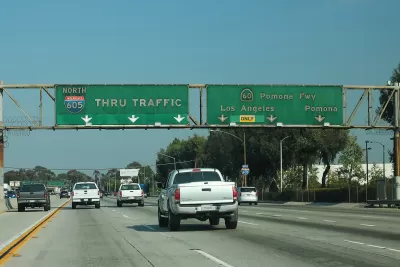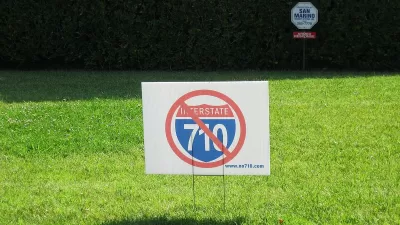The 605 freeway expansion project was expected to demolish hundreds of homes and multifamily buildings.

In a victory for freeway fighters and anti-displacement activists, the Los Angeles County Metropolitan Transportation Authority (Metro) announced the Metro and Caltrans 605 Freeway Corridor Improvement Project (605CIP), which, per its initial plans, would have displaced hundreds of residents and impacted more than a thousand parcels in the area.
The news was announced by Metro Senior Director of Countywide Planning and Development Isidro Pánuco at a meeting of the Metro Board Planning and Programming Committee on Wednesday and reported by Joe Linton in Streetsblog LA.
“This is the first time that Metro staff has announced publicly and unequivocally that the 605CIP will not demolish homes,” Linton notes. “Nevertheless, Metro and Caltrans are still planning to proceed with widening the 605, the 5, and many many more Southern California freeways during a time when the dire impacts of the global climate catastrophe are becoming increasingly hard to ignore.”
FULL STORY: Metro Announces 605 Freeway Widening Project Will Not Demolish Homes

Trump Administration Could Effectively End Housing Voucher Program
Federal officials are eyeing major cuts to the Section 8 program that helps millions of low-income households pay rent.

Planetizen Federal Action Tracker
A weekly monitor of how Trump’s orders and actions are impacting planners and planning in America.

The 120 Year Old Tiny Home Villages That Sheltered San Francisco’s Earthquake Refugees
More than a century ago, San Francisco mobilized to house thousands of residents displaced by the 1906 earthquake. Could their strategy offer a model for the present?

Austin Launches $2M Homelessness Prevention Fund
A new grant program from the city’s Homeless Strategy Office will fund rental assistance and supportive services.

Alabama School Forestry Initiative Brings Trees to Schoolyards
Trees can improve physical and mental health for students and commnity members.

NYC Outdoor Dining Could Get a Re-Do
The city council is considering making the al fresco dining program year-round to address cost concerns from small businesses.
Urban Design for Planners 1: Software Tools
This six-course series explores essential urban design concepts using open source software and equips planners with the tools they need to participate fully in the urban design process.
Planning for Universal Design
Learn the tools for implementing Universal Design in planning regulations.
Ada County Highway District
Clanton & Associates, Inc.
Jessamine County Fiscal Court
Institute for Housing and Urban Development Studies (IHS)
City of Grandview
Harvard GSD Executive Education
Toledo-Lucas County Plan Commissions
Salt Lake City
NYU Wagner Graduate School of Public Service





























